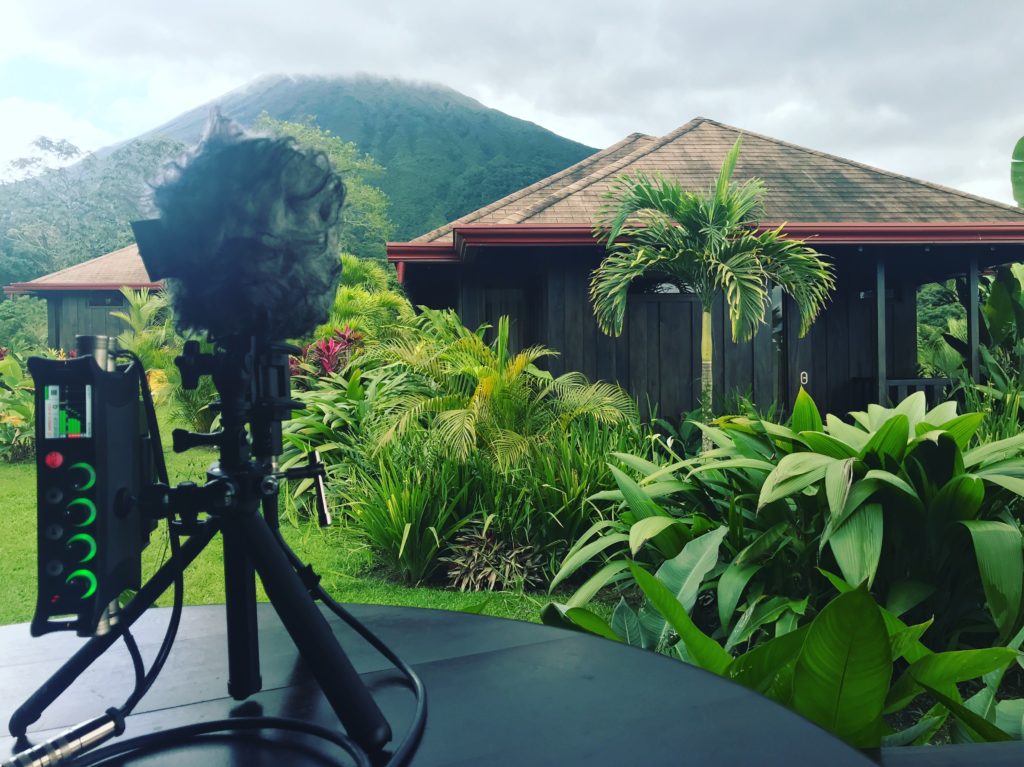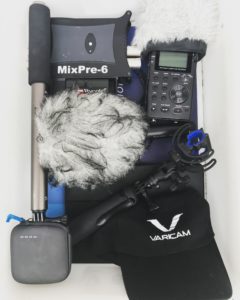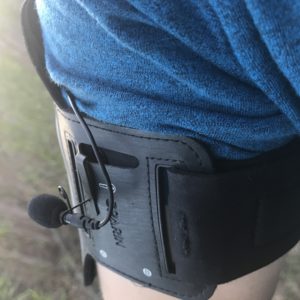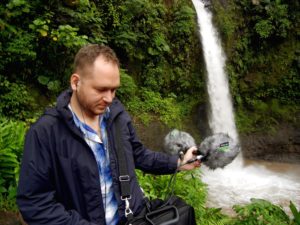
For anyone that has spent time in Manhattan, the city has its own sonic roar that makes it uniquely identifiable as New York. Pro Sound Effects has released a library, NYC Ambisonics, which embodies this idea and really inspired me as a designer to start using and recording my own ambiences.
As a sound designer, traveling has the added benefit of providing the opportunity to capture sound in many unique spaces. When I am in between projects, my wife and I love to travel. I’ve made it my goal to record ambiences everywhere we go–to capture the unique character of each space. Some people take pictures when they travel; I collect sounds.
Most recently, we visited Costa Rica. This was our third time there, and I had previously gotten some great recordings, so planned to record there again; however, this time I went with the ambisonics format. While I recorded an array of sounds, a few stood out as my favorites. The first was at the beginning of our journey when we visited La Fortuna. This is a small town at the base of a volcano, surrounded by rainforest. There is one resort in particular we had stayed at on a previous visit; it stands out to me in its remote proximity to the rainforest and nearby volcano. Each night, I would hike in towards the nearby rainforest and capture some amazing sounds. Below is a sample from one of those recordings:
When in remote locations such as this one, I also tend to let a recorder run overnight and see what random creatures wander by.

Both times visiting this area, we hired a raft and floated down the nearby Peñas Blancas river. In situations like this, I tend to just let the mic roll for the duration and edit it down to usable chunks back in the studio. Here is an excerpt from that recording:
Building the ultimate mobile recording rig for ambisonics recording
Over the years, the kit I bring along when I travel has gone through many drastic changes. My first kit was a simple Zoom H4n. My next recorder was a Tascam DR-100mkii. I was one of the first people to pick up the Sennheiser Ambeo VR when it came out and I immediately fell in love. As a mixer, having ambiences recorded in ambisonics format allowed me the flexibility to adapt the recordings to virtually any format in post. At the time, the Sound Devices 788T was my primary recorder, which meant every time I travelled I needed to save room for the 788, Ambeo VR, Rycote Baby Ball Gag, and CL-WiFi – which was a lot of gear!
For me, the key to building a slim, yet powerful rig was the combination of the Sound Devices  MixPre-6 and Sennheiser Ambeo VR. In preparation for a series of trips over the summer, I picked up a Sound Devices MixPre-6 and had Chase over at Gotham Sound make a custom DIN-12 to XLR fanout cable to cut down on the footprint as much as possible. For a bag, I went with the K-Tek MixPro bag. For powering on my first trip, I used the recommended Anker battery, which was great, but it added a lot of weight and size to an otherwise small footprint. For my most recent trip to Costa Rica, I picked up the Sound Devices MX-LMount dual battery sled. With two NP-F550 batteries, I was able to go days without having to recharge or swap batteries.
MixPre-6 and Sennheiser Ambeo VR. In preparation for a series of trips over the summer, I picked up a Sound Devices MixPre-6 and had Chase over at Gotham Sound make a custom DIN-12 to XLR fanout cable to cut down on the footprint as much as possible. For a bag, I went with the K-Tek MixPro bag. For powering on my first trip, I used the recommended Anker battery, which was great, but it added a lot of weight and size to an otherwise small footprint. For my most recent trip to Costa Rica, I picked up the Sound Devices MX-LMount dual battery sled. With two NP-F550 batteries, I was able to go days without having to recharge or swap batteries.
Choosing when and where to record
Having the right gear is only half the battle. While it is easy to want to record everything, I have learned that when recording ambiences, it is important to think “how will I be able to use these sounds in a mix?” When visiting a space for the first time, it is important to take a moment to listen to the world around you and consider how you will use what you record.
For example, “Is there anything unique about this space?”
Chances are if you set up a microphone right next to a large waterfall, the only sound you are going to get is a wall of white noise.
If there is nothing unique or discernible about the sound you are about to capture, I tend to choose to enjoy the experience instead and keep the recorder in the bag.
Is there anything in the environment, sonically, that may keep me from using this recording?
The first thing I listen for is anything in the environment that will make the recording unusable. Primarily, I am listening for music or TV playing in the background. If there is, this can run you into copyright issues, so I tend to take this as another example of when to keep the recorder in the bag.
Sometimes you have to think outside the box

While in Costa Rica, zip-lining is one of the fun and adventurous things you can do. I have on past occasions thought to myself, “the sound of the pulleys running down those steel cables is really cool.” On this trip I decided I was going to try to capture it. I decided I was not going to strap the MixPre-6 and Ambeo VR to my chest, so I had to come up with a more creative solution. What I ended up doing was putting my iPhone in an athletic armband and wiring a Røde SmartLav+ to the outside of the armband recording to Røde’s Rec app. While this may not be the HIGHEST quality recording possible, this setup allowed me to get the sound I wanted. You can listen to the result below:
Often times, when recording in public, I try to be as covert as possible. When you set up a recorder and mic on a tripod, I have often run into the problem of people either wanting to play twenty questions or succumb to the urge to sing into the mic. For this reason, I like to keep my recorder concealed in my backpack and will let the mic sit in my bag with only the Baby Ball Gag sticking out of the top.
Get the sound you need, but also know when to walk away
When recording in the field, you will occasionally be asked to stop recording. I find the best approach in this situation is to be apologetic and move on. If you feel the need to argue, it is best to be familiar with the rules and laws regarding public recording for the city or country you are visiting as they vary greatly from place to place. This is another reason why it is important to record as discreetly as possible.
Have fun
Over the years, I have captured some pretty great sounds simply by being in the right place at the right time. As a sound designer, the more material you have to work with, the more creative you can be. While not everything I record will make it onto the big screen, capturing sounds and having a story behind them is still a great way to make memories while on vacation.

Awesome article! I too like to pack lightly as possible. Are there any things that you’ve found to be particularly multifunctional when traveling? For instance, the Rode Lav was a smart choice for the Zip-Line but do you always carry that with you? I love the little accessories that serve various purposes!
Thanks, Like. Glad you enjoyed it! Yes, the SmartLav+ has become an easy -bring everywhere solution, simply because it plugs right into the iPhone and gets a pretty clean recording of hard effects. For ambiences, I try to either have my Tascam DR100mkii or Ambeo VR + MixPre-6 with me when I am planning to record somewhere I am traveling that day. Another newcomer to the scene is the Lectrosonics SPDR. I am currently demoing and have been really impressed! That plus two DPA 4060 lavs make for a super compact two channel solution. All that being said, sometimes you just use what you have. If I hear something cool happening in the moment, I am one to pull out my iPhone and just start recording with the internal mic if that is all I have.
What is the make of tripod & mix pre attachment? Looking for a similar small footprint stand!
Hi there,
Here is the specific clamp I purchased, but any clamp with a 1/4-20 should work to mount to the MixPre-6:
https://www.amazon.com/gp/product/B0786C4J81/ref=oh_aui_detailpage_o00_s01?ie=UTF8&psc=1
For the stand in the article, I am using the GoPro Fusion tripod, with a GoPro to 1/4-20 adapter that I share between my Rycote INV-7 and the GoPro Fusion. However, any compact mic stand should work the same, I just wanted one that I could easily swap out with the GoPro.